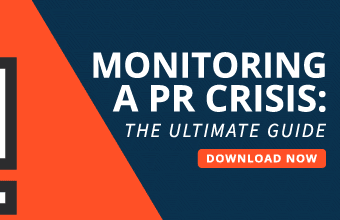You’ve worked hard to establish a trustworthy identity for your eCommerce brand and lead it to the success that it is today. So, what happens when a PR crisis strikes, and you suddenly face a disaster threatening to undo everything you’ve worked so hard to build?
In a world where the slightest expression of a customer’s dissatisfaction or a social media callout can spread like wildfire, it is vital to have a crisis management plan in place.
In this article, we will talk about the steps you must take when handling an ongoing PR crisis and advise you on how to prepare for—but preferably avoid—difficult situations threatening your eCommerce brand’s public image and reputation.
What is PR crisis management?
PR crisis management involves taking control of a situation where your business receives negative attention or publicity. It is a fundamental part of running an eCommerce business because a PR crisis puts your brand’s reputation at stake, bringing along a high risk of loss of revenue.
There are various types and levels of PR crises eCommerce businesses can face.
- Data breaches
- False advertising
- Problematic collaborations
- Negative reviews
- Social media backlash
- Employee misconduct
- Internal disputes
- Environmental damage
- Supply chain problems, e.g., faulty product recalls or shortages
Having a crisis management plan in place is essential because, in such situations, things can escalate quickly, and it can be challenging to regain control. These are public matters and don’t happen in controlled environments. A proper plan will help you act quickly and tactfully to mitigate the situation.
Tips and strategies for eCommerce business owners and managers
Here are some practical recommendations on how your eCommerce business can prepare for a crisis before it happens and some helpful tactics for handling one if it happens anyway.
Being prepared: What if…
The three basic steps for preparing for a PR crisis are:
- Coming up with a formal crisis management plan
- Formulating a communication strategy
- Assembling and training a crisis management team, clearly defining each team member’s role so prompt action can be taken if or when the time comes, and including representatives from different stakeholder groups and departments such as management, marketing, customer service, and legal, along with spokespersons and PR specialists
If you want to be even better prepared, there are more steps you can take. You can start with periodic risk assessments, which you can break down into three pivotal phases:
- Identify potential PR risks your eCommerce business could face
- Prioritise these risks based on the likelihood of their occurrence and the level of impact they can leave
- Take appropriate measures to avoid or mitigate these risks (for example, if you think you’re vulnerable to supply chain issues, invest in proper inventory management software, or if you are launching a new marketing campaign that could come off as false advertising, run it by legal first)
Another preparatory step is social listening for sentiment analysis, where you put out feelers to continuously gather data on whether your customers have been talking about your brand in a positive, negative, or neutral light.
Doing so can significantly help monitor and manage your brand’s reputation online. For an invaluable learning experience, you can do this for not only your own brand but also competing eCommerce businesses to see the kind of trouble they land in and how they handle it.
You can also work on creating templates for crisis communication messages such as press releases, social media posts, and emails so that you can respond quickly in an emergency without straying from your brand’s public voice and tone. These templates should be revised and refreshed regularly so that your statements don’t sound repetitive or insincere.
Other precautionary steps include building connections with media outlets, journalists, and influencers who can help you quickly distribute your responses to mass audiences, conducting drills, and training and learning from past experiences.
By taking these steps, eCommerce businesses can be better prepared to handle a PR crisis and ensure their brand’s reputation remains intact.
Avoiding a PR crisis: Nip it in the bud
As they say, prevention is better than cure. While it’s great to be prepared for the worst possible PR nightmare, it’s much better to do your best to avoid waking up into one. Here are some steps that you can take to prevent a PR crisis in the first place.
First and foremost, have a set of in-house rules that all team members must follow when representing the brand on public platforms. Relevant managers or departments must approve all content before it’s published.
Another important—and perhaps obvious—step is to build strong customer relationships. There are several ways to do that. Maintaining a high quality of products would be a good start. Investing in top-notch after-sales support and customer service also helps foster customer trust and loyalty. Even if customers have occasional complaints, they will first come to you privately instead of going straight for a public callout.
Proactively addressing customer feedback and accordingly improving product quality helps you stay on top of issues before they turn into bigger problems. It makes your customers feel heard and valued. You don’t have to act on every single piece of feedback you receive, but repeated complaints or requests mean something is lacking on your part. Flexible returns and exchange policies favouring your customers can also help avoid negative feedback.
To avoid crises caused by legal trouble, it’s vital to comply with local or global laws and regulations. Fulfilling your corporate social responsibility can further promote a positive brand image.
Managing a PR crisis: “It’s happened. Now what?”
Different types of crises require different strategies. But keeping in mind some general rules can help you navigate a PR crisis in the best possible way, with minimal damage to your reputation.
Crisis communication requires 100% transparency and honesty. Rather than wasting time playing the blame game, take accountability as a team. Make sure that the whole team is on the same page so you can present a united front. Be honest about the severity of the situation so the team can take the best possible route. PR emergencies often require quick thinking for time-critical responses, so close collaboration among team members is crucial.
It’s important to take charge in crisis management. Don’t go silent because people will either perceive it as an admission of guilt or start filling in the gaps for you, voicing their own terrible assumptions, both of which will multiply the damage. That doesn’t mean you should rush to respond without careful consideration. There’s no room for panicked or angry reactions. Instead, accept responsibility, apologise, and choose the right words to show your remorse. Propose well-thought-out solutions that reflect your eagerness to resolve the issue.
Next, focus on taking the issue off public platforms as soon as possible. For example, if an unhappy customer has raised an issue about your brand on Twitter, politely ask them to DM their complaint and reassure them that you will resolve it on high priority.
Don’t misbehave or be rude at any cost, even (read: especially) after the issue has been transferred to a private setting. Remember, people can still screenshot your chat and email correspondence or record your calls and audio clips, so be on your best behaviour throughout the process.
If you’re expected to issue a public statement, choose the external communication channel that works best for your brand. It could be your LinkedIn business page, blog post, website announcement, press release, or even television appearance.
Finally, be careful not to make false promises during the crisis resolution process; otherwise, you’ll have one more problem to deal with.
Wrapping up
In this age of virality, with customers having multiple channels and platforms to voice their complaints and concerns, it’s paramount for eCommerce businesses such as yours to have a contingency plan in place. You could land in trouble for the slightest mishap or oversight.
We’ve covered the three fundamental levels of any PR crisis.
- Avoidance: Take appropriate steps, such as working on your product and service quality, acting quickly on repeated complaints, and complying with any applicable laws, to ensure that a crisis situation doesn’t occur in the first place.
- Preparation: You need to be ready in case something does go wrong despite your best efforts. This is where all the precautionary planning happens. Have a team ready on standby. Keep some pre-prepared responses on hand so you can issue statements quickly in case of an emergency. Conduct some practice drills.
- Management: The last, worst-case phase is the actual crisis, which needs to be handled quickly yet tactfully with a cool head if you want to minimise the havoc it could potentially wreak.
Remember, a PR crisis can happen to any business, but a proactive approach can prevent your eCommerce brand from becoming a cautionary tale for others in the industry.








